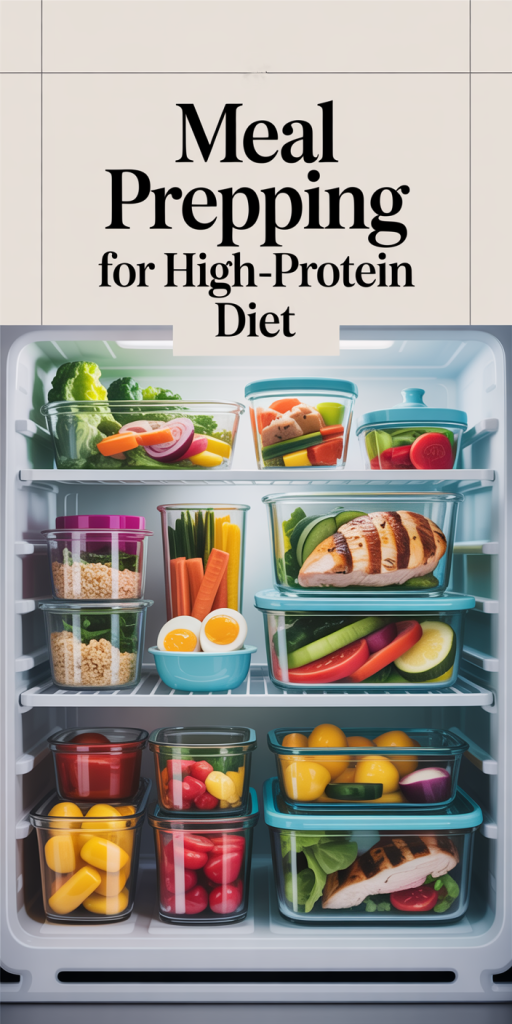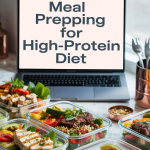Ultimate Guide to Meal Prepping for High-Protein Diet: Boost Your Nutrition Today
If you’re looking to boost your protein intake without spending hours in the kitchen, meal prepping is your best friend. I’ve discovered that planning and preparing meals in advance not only saves time but also keeps me on track with my high-protein diet goals. Whether you’re an athlete, a fitness enthusiast, or just someone wanting to eat healthier, meal prepping can transform your approach to nutrition.
Benefits Of Meal Prepping For High-Protein Diet
Meal prepping offers numerous advantages for those following a high-protein diet. It streamlines the process of meal planning and ensures consistent protein intake without the daily hassle.
Saves Time
Saves time throughout the week by allowing me to prepare multiple meals in one session. Cooking protein-rich foods, like chicken, beans, and quinoa, in bulk prevents the need for daily preparation. Portioning meals in advance means no last-minute cooking during busy days. This proactive approach allows me to focus on workouts or other tasks while still meeting my dietary goals.
Cost-Effective
Meal prepping proves cost-effective by reducing food waste and allowing me to buy ingredients in bulk. Purchasing high-protein sources, like eggs or lentils, in larger quantities lowers the overall cost per serving. Planning meals also helps me avoid impulse purchases and reduces reliance on more expensive convenience foods. By maximizing resources, meal prepping supports both budget and health goals effectively.
Key Components Of High-Protein Meal Prep
High-protein meal prep involves selecting the right ingredients and using suitable storage solutions. This ensures meals stay fresh while maximizing protein intake.
Protein Sources
- Lean Meats: Chicken breast, turkey, and lean cuts of beef or pork contain abundant protein.
- Fish: Salmon, tuna, and cod are not only high in protein but also rich in omega-3 fatty acids.
- Eggs: Eggs provide complete proteins along with essential vitamins and minerals.
- Legumes: Beans, lentils, and chickpeas serve as excellent plant-based protein sources.
- Dairy: Greek yogurt, cottage cheese, and low-fat milk supply protein and calcium.
- Nuts and Seeds: Almonds, walnuts, chia seeds, and flaxseeds add healthy fats along with protein.
- Protein Powders: Whey, casein, or plant-based protein powders boost protein levels in shakes and smoothies.
Meal Prep Containers
- Bento Boxes: These compartments help separate different food items, making portion control simple.
- Mason Jars: Ideal for salads or layered meals, they keep items fresh and visually appealing.
- Freezer Bags: Great for bulk prepping and freezing soups, stews, or prote-packed snacks.
- Glass Containers: Durable and refrigerator-friendly, these containers resist stains and odors while being microwave-safe.
- Plastic Containers: Lightweight, stackable, and economical; they offer a range of sizes for various meal portions.
- Thermal Bags: Perfect for transporting meals, they help keep food hot or cold during travel.

Meal Prep Ideas For High-Protein Diet
Meal prepping helps create a variety of high-protein meals that align with dietary goals. Here are some practical ideas for breakfast, lunch, dinner, and snacks.
Breakfast Options
- Overnight oats: Combine rolled oats with Greek yogurt and almond milk. Add chia seeds, berries, and nuts for extra protein and flavor.
- Egg muffins: Whisk eggs with diced vegetables and lean meats. Pour the mixture into muffin tins and bake for individual servings packed with protein.
- Protein pancakes: Mix protein powder with oats and eggs to create a high-protein pancake batter. Cook and freeze them for a quick breakfast option.
- Smoothie packs: Pre-portion smoothie ingredients like spinach, banana, and protein powder into freezer bags. Blend with your choice of liquid in the morning.
Lunch and Dinner Choices
- Grilled chicken salad: Marinate chicken breast and grill it. Serve over a bed of mixed greens with beans, corn, and a high-protein dressing, like tahini.
- Quinoa bowls: Prepare quinoa and top it with black beans, grilled veggies, and a protein source, like grilled tofu or chickpeas. Add a squeeze of lime for taste.
- Baked fish: Season fish fillets such as salmon or tilapia with herbs and bake. Pair with roasted vegetables for a complete meal.
- Stir-fried tofu: Stir-fry firm tofu with assorted vegetables and a low-sodium soy sauce. Serve over brown rice or quinoa for added protein.
Snack Ideas
- Protein bars: Make batch snacks using oats, nut butter, and protein powder. Cut them into bars for on-the-go protein options.
- Hummus and veggies: Prepare single-serving containers of hummus and pair them with carrot sticks, cucumber slices, or bell pepper strips for a nutritious snack.
- Greek yogurt parfaits: Layer Greek yogurt with nuts and fruits in portable containers. This provides a convenient, nutrient-rich snack.
- Hard-boiled eggs: Boil eggs and store them in the fridge for a quick, protein-packed snack option. Sprinkle with salt or pepper for flavor.
Tips For Successful Meal Prepping
Meal prepping enhances the effectiveness of a high-protein diet when approached with strategic planning and proper techniques. Here are some essential tips to ensure successful meal prep.
Planning Your Week
Planning my week starts with setting specific meal goals based on my protein requirements. I create a detailed menu, outlining each meal, snack, and their respective protein sources. I allocate a day for shopping, compiling a comprehensive grocery list that includes ingredients for my high-protein meals. I prioritize batch cooking; preparing larger portions of proteins, grains, and vegetables saves time during the week. Incorporating a variety of flavors keeps meals exciting and prevents monotony.
Storage and Reheating Techniques
Storage and reheating techniques significantly affect meal quality. I use airtight containers to maintain freshness, opting for glass or BPA-free plastic to avoid harmful chemicals. I label containers with meal names and dates to ensure proper rotation. Portion control is essential; I pack individual servings to simplify meals throughout the week. For reheating, I use microwave-safe containers, ensuring even heating by stirring meals midway or microwaving in intervals. This approach preserves texture and flavor, making my high-protein meals enjoyable.
Conclusion
Embracing meal prepping for a high-protein diet has transformed my approach to eating. It’s not just about convenience; it’s a game changer for staying on track with my health goals. I’ve found that planning ahead not only saves time but also keeps my meals exciting and varied.
By selecting the right ingredients and utilizing effective storage solutions, I can enjoy delicious protein-packed meals throughout the week. Whether I’m fueling up for a workout or simply looking to maintain a balanced diet, meal prepping has proven to be an invaluable tool in my journey. I encourage you to give it a try and experience the benefits for yourself. Your body will thank you!




